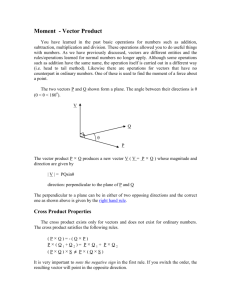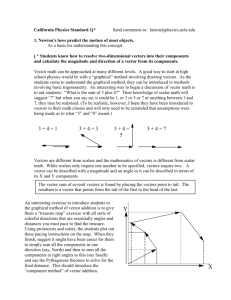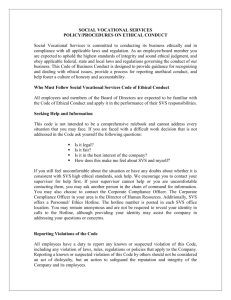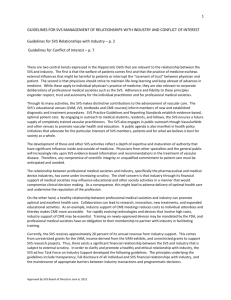Simplifying support vector solutions
advertisement
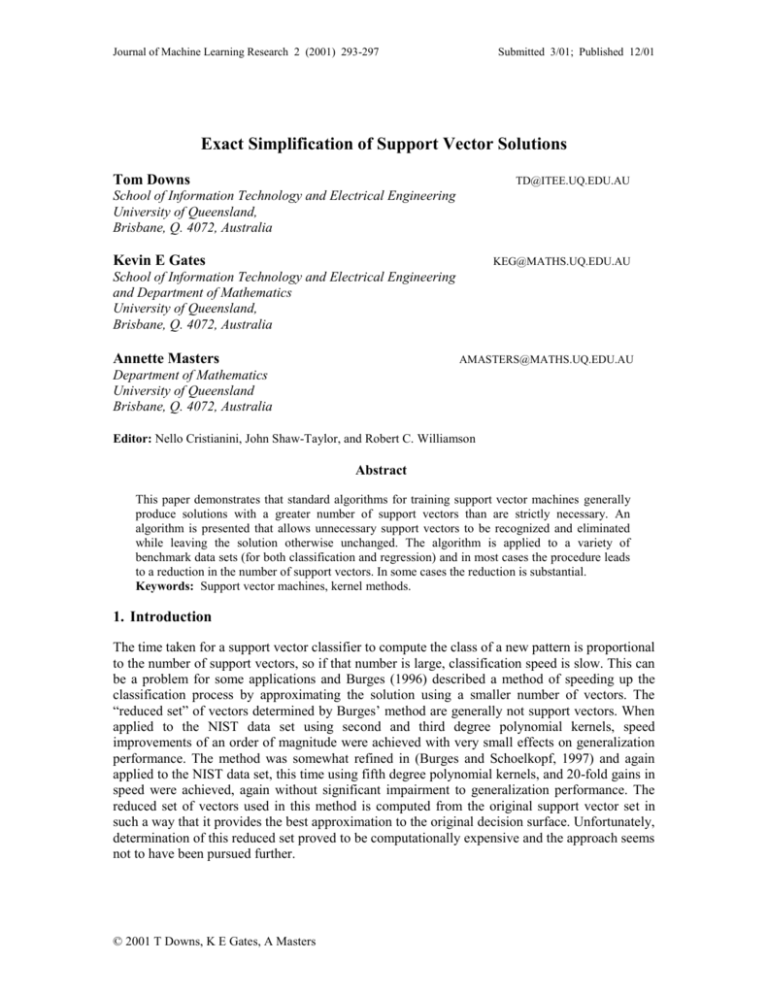
Journal of Machine Learning Research 2 (2001) 293-297 Submitted 3/01; Published 12/01 Exact Simplification of Support Vector Solutions Tom Downs TD@ITEE.UQ.EDU.AU School of Information Technology and Electrical Engineering University of Queensland, Brisbane, Q. 4072, Australia Kevin E Gates KEG@MATHS.UQ.EDU.AU School of Information Technology and Electrical Engineering and Department of Mathematics University of Queensland, Brisbane, Q. 4072, Australia Annette Masters AMASTERS@MATHS.UQ.EDU.AU Department of Mathematics University of Queensland Brisbane, Q. 4072, Australia Editor: Nello Cristianini, John Shaw-Taylor, and Robert C. Williamson Abstract This paper demonstrates that standard algorithms for training support vector machines generally produce solutions with a greater number of support vectors than are strictly necessary. An algorithm is presented that allows unnecessary support vectors to be recognized and eliminated while leaving the solution otherwise unchanged. The algorithm is applied to a variety of benchmark data sets (for both classification and regression) and in most cases the procedure leads to a reduction in the number of support vectors. In some cases the reduction is substantial. Keywords: Support vector machines, kernel methods. 1. Introduction The time taken for a support vector classifier to compute the class of a new pattern is proportional to the number of support vectors, so if that number is large, classification speed is slow. This can be a problem for some applications and Burges (1996) described a method of speeding up the classification process by approximating the solution using a smaller number of vectors. The “reduced set” of vectors determined by Burges’ method are generally not support vectors. When applied to the NIST data set using second and third degree polynomial kernels, speed improvements of an order of magnitude were achieved with very small effects on generalization performance. The method was somewhat refined in (Burges and Schoelkopf, 1997) and again applied to the NIST data set, this time using fifth degree polynomial kernels, and 20-fold gains in speed were achieved, again without significant impairment to generalization performance. The reduced set of vectors used in this method is computed from the original support vector set in such a way that it provides the best approximation to the original decision surface. Unfortunately, determination of this reduced set proved to be computationally expensive and the approach seems not to have been pursued further. © 2001 T Downs, K E Gates, A Masters DOWNS, GATES AND MASTERS More recently it has been shown (Syed et al., 1999) that the discarding of even a small proportion of the support vectors can lead to a severe reduction in generalization performance. Syed et al. (1999) stated that this implies that the support vector set chosen by the SVM is a minimal set. But Burges (1996) and Burges and Schoelkopf (1997) had already pointed out that there exist non-trivial cases where the reduced set approximation is exact, showing that the support vector set delivered by the SVM is not always minimal. Burges and Schoelkopf offered no explanation for this phenomenon. In this paper we explain circumstances in which a reduced set can be computed that avoids any approximation. The required computation is essentially trivial and basically involves discarding unnecessary support vectors and modifying the Lagrange multipliers of the remaining support vectors so that the solution remains unchanged. 2. Reducing the Number of Support Vectors 2.1 Pattern Classification Suppose we train an SVM classifier with pattern vectors xi, and that r of these are determined to be support vectors. Denote them by xi, i = 1,2, . . . ,r. The decision surface for pattern classification then takes the form r iyiK ( x, xi) b f ( x) (1) i 1 where i is the Lagrange multiplier associated with pattern xi and K( ) is a kernel function that implicitly maps the pattern vectors into a suitable feature space. Now suppose that support vector xk is linearly dependent on the other support vectors in feature space, i.e. r K ( x, x k ) ci K ( x , xi ) (2) i 1 ik where the ci are scalar constants. Then the decision surface (1) can be written r r i 1 ik i 1 ik f ( x ) i y i K ( x, xi ) kyk ciK ( x, xi ) b (3) Now define kykci = iyii so that (3) can be written f ( x) r (1 i 1 ik i i ) yi K ( x, x i ) b r i yi K ( x, x i ) b (4) i 1 ik where i i(1 i) (5) Comparing (4) and (1) we see that the linearly dependent support vector is not required in the representation of the decision surface. Note, however, that the Lagrange multipliers must be 294 EXACT SIMPLIFLIFICATION OF SUPPORT VECTOR SOLUTIONS modified according to (5) in order to obtain the simplified representation. But this is a very simple modification that can be applied to any linearly dependent support vector that is identified. 2.2 Regression For regression problems the support vector solution takes the form f ( x) r i *i ) K ( x, xi) b i 1 which can be written f ( x) r iK ( x, xi) b (6) i 1 where i = i or i = – i*, depending on which constraint is active. Now suppose support vector xk is linearly dependent on the other support vectors in feature space according to (2). We then find, as for the classification case, that xk can be eliminated from (6) and this gives f ( x) r i K ( x, xi) b (7) i 1 where i = i + kci. 3. Results In order to determine the simplifications that are possible using this method, we need to be able to identify support vectors that are linearly dependent in feature space. This can be done using techniques from elementary linear algebra and we employ the row reduced echelon form (Noble and Daniel, 1988). The results below indicate the degree of simplification achieved on solutions obtained using standard SVM procedures on several benchmark data sets. We do not give any indication of generalization performance because the simplifications leave performance unchanged. 3.1 Classification Results for classification were obtained using four data sets arbitrarily selected from the UCI database. We employed the SMO algorithm (Platt, 1999) to generate an initial support vector set and then applied the method described in Section 2.1 to eliminate support vectors that are linearly dependent in feature space. We used linear, polynomial and RBF kernels and the results are detailed in Tables 1 – 3. Linear Kernel (xi xj) SMO # SVs Modified set # SVs Reduction in SVs Data Sets Diabetes Haberman Contraceptive Method Choice 28 7 75.0% 100 8 92.0% 16 3 81.25% Table 1 : Results using the linear kernel 295 Wisconsin Breast Cancer 21 9 57.14% DOWNS, GATES AND MASTERS Polynomial Kernel (xi xj + 1) d=1 d=2 d=3 d=4 d=5 d=6 d=7 d SMO # SVs Modified set # SVs Reduction in SVs SMO # SVs Modified set # SVs Reduction in SVs SMO # SVs Modified set # SVs Reduction in SVs SMO # SVs Modified set # SVs Reduction in SVs SMO # SVs Modified set # SVs Reduction in SVs SMO # SVs Modified set # SVs Reduction in SVs SMO # SVs Modified set # SVs Reduction in SVs Contraceptive Method Choice 9 7 22.22% 12 11 8.33% 23 23 0.0% 24 23 4.12% 32 31 3.13% 28 28 0.0% 12 11 8.33% Data Sets Diabetes Haberman 79 9 88.61% 48 42 12.5% 171 141 17.54% 106 106 0.0% 241 213 11.62% 269 165 38.66% 239 119 50.21% 42 4 90.45% 87 10 88.51% 91 18 80.22% 79 29 63.29% 46 32 30.44% 63 41 34.92% 42 38 9.52% Wisconsin Breast Cancer 21 10 52.38% 12 11 8.33% 17 17 0.0% 29 28 3.45% 13 11 15.39% 14 13 7.14% 20 20 0.0% Table 2 : Results using the polynomial kernel RBF Kernel =1.5 =2.0 =2.5 =3.0 =3.5 SMO # SVs Modified set # SVs Reduction in SVs SMO # SVs Modified set # SVs Reduction in SVs SMO # SVs Modified set # SVs Reduction in SVs SMO # SVs Modified set # SVs Reduction in SVs SMO # SVs Modified set # SVs Reduction in SVs Contraceptive Method Choice 50 50 0.0% 50 50 0.0% 183 176 3.83% 73 73 0.0% 294 207 29.59% Data Sets Diabetes Haberman 48 47 2.08% 50 49 2.0% 49 48 2.04% 134 51 61.94% 137 44 67.88% Table 3 : Results using RBF kernels 296 21 21 0.0% 23 22 4.35% 69 46 33.3% 55 30 45.45% 35 24 31.43% Wisconsin Breast Cancer 54 53 1.85% 56 53 5.36% 86 79 8.14% 107 91 14.95% 130 114 12.31% EXACT SIMPLIFLIFICATION OF SUPPORT VECTOR SOLUTIONS 3.2 Regression For the regression case, the initial support vectors were generated using SVMTorch (Collobert and Bengio, 2001) on a data set of 4000 points also provided in Collobert and Bengio (2001). Equation (7) was then used to eliminate those support vectors that were identified as linearly dependent. The simplifications obtained are detailed in Table 4. RBF Kernel = 900 = 915 = 950 = 1000 = 1050 SVMTorch - # SVs 597 600 599 613 625 Modified set - #SVs 412 408 394 384 369 Reduction in SVs 30.99% 32.00% 34.22% 37.36% 40.96% Table 4 : Results using RBF kernels for regression 4. Discussion Tables 1-4 demonstrate that in most cases our procedure leads to a reduction in the number of support vectors and in some cases a substantial reduction. The amount of reduction achievable is both kernel and problem dependent and does not appear to be predictable a priori. However, the examples indicate that larger reductions tend to occur with lower degree polynomial kernels and with RBF kernels having larger values. Note that the solutions we obtain are not generally unique. Linear dependence is a collective property of the support vectors and the choice of which support vectors to eliminate is not a unique one. This indicates that those support vectors that Vapnik terms essential (Vapnik, 1998) are the ones that are linearly independent before the implementation of our procedure. We are currently developing an SVM training algorithm that will generate linearly independent support vectors only. Acknowledgement This work was supported by the Australian Research Council, Grant Number A49937172. References C. J. C. Burges. Simplified support vector decision rules. Proceedings 13th International Conference on Machine Learning, Bari, Italy, 1996, pp 71-77. C. J. C. Burges and B. Schoelkopf. Improving speed and accuracy of support vector learning machines. Advances in Neural Information Processing Systems, 9, MIT Press, 1997, 375-381. R. Collobert and S. Bengio. SVMTorch: Support Vector Machines for Large-Scale Regression Problems” Journal of Machine Learning Research, 1:143-160, 2001. B. Noble and J. W. Daniel. Applied Linear Algebra. 3rd Edition, Prentice-Hall, 1988. J. Platt. Fast Training of support vector machines using sequential minimal optimization. In B. Schölkopf, C. J. C. Burges, and A. J. Smola, editors, Advances in Kernel Methods – Support Vector Learning, pages 185-208, 1999, MIT Press. N. A. Syed, H. Liu and K. K. Sung. Incremental Learning with Support Vector Machines. Proceedings of Workshop on Support Vector Machines at International Joint Conference on Artificial Intelligence, Stockholm, 1999. V. N. Vapnik. Statistical Learning Theory. Wiley, New York, 1998. 297



